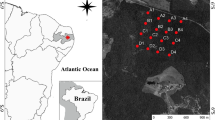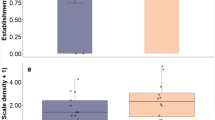Summary
The rate at which fallen hickory nuts are removed from beneath the parent tree, and the effect on this rate of the seed predatorConotrachelus affinis, was studied in an oak-hickory forest in southeastern Michigan, USA, during a year in which few nuts were produced. The trees responded toConotrachelus, which destroyed half the nut crop, by aborting inviable nuts during the summer. The seed dispersers, mostly gray squirrels, removed fallen nuts rapidly, showing the ability to distinguish viable nuts and remove them preferentially. The number of nuts removed in a week varies directly with the number available, and removal rate increases when many viable nuts are falling. The death of most seeds before dispersal, and the squirrels' efficiency at foraging on nuts and recovering them after burial, imply that successful hickory reproduction takes place only in years of heavy nut production.
Similar content being viewed by others
References
Barber, H.L.: Gray and fox squirrel food habit investigations. Proc. Southeastern Assoc. Game and Fish Commissioners8, 92–94 (1954)
Barton, L.V.: Seedling production inCarya ovata (Mill.) K. Koch,Juglans cinerea L., andJuglans nigra L. Contr. Boyce Thompson Inst.8, 1–5 (1936)
Beal, J.A.: The more important insects of Duke Forest and the Piedmont Plateau. Duke Univ. School Forestry Bull44, 18–24 (1952)
Brooks, F.E.: Curculios that attack the young fruits and shoots of walnut and hickory. U.S. Dept. Agriculture Bull. 1066, 16 pp. (1922)
Brown, L.G., Yeager, L.E.: Fox squirrels and gray squirrels in Illinois. Ill. Nat. Hist. Survey Bull.23, 448–536 (1945)
Cahalane, V.H.: Caching and recovery of food by the western fox squirrel. J. Wildl. Mgmt.6, 338–352 (1932)
Christisen, D.M.: Yield of seed by oak in the Missouri Ozarks. J. Forestry53, 439–441 (1955)
Collingwood, G.H.: Pignut hickory,Hicoria glabra. Amer. Forests43, 546–547 (1937)
Dalke, P.D.: Yield of seeds and mast in second growth hardwood forest, southcentral Missouri. J. Wildl. Mgmt.17, 378–386 (1953)
Davison, V.C.: Selection of foods by gray squirrels. J. Wildl. Mgmt.28, 346–352 (1964)
Downs, A.A.: Estimating acorn crops for wildlife in the southern Applachians. J. Wildl. Mgmt.8, 339–340 (1944)
Downs, A.A., McQuilken, W.E.: Seed production of southern Appalachian oaks. J. Forestry42, 913–920 (1944)
Elias, T.S.: The genera of Juglandaceae in the southeastern U.S. J. Arnold Arboretum53, 26–51 (1972)
Formosof, A.N.: The crop of cedar nuts, invasions into Europe of the Siberian nutcracker (Nucifraga caryoctactes macrorhynchus Brehm) and fluctuations in numbers of the squirrel (Sciurus vulgaris L.). J. anim. Ecol.2, 70–81 (1933)
Fox, J.F.: Coevolution of white oak and its seed predators. Ph.D. thesis, Univ. of Chicago, 90 pp. (1974)
Gashwiler, J.S.: Further study of conifer seed survival in a western Oregon clearcut. Ecology51, 849–854 (1970)
Gibson, L.P.: Biology and life history of acorn-infesting weevils of the genusConotrachelus (Coleoptera: Curculionidae). Ann. ent. Soc. Amer.57, 521–526 (1964)
Gibson, L.P.: Insects of bur oak acorns. Ann. ent. Soc. Amer.64, 232–234 (1971)
Gibson, L.P.: Insects that damage white oak acorns. U.S. Forest Service Research Paper NE-220, 7 pp (1972)
Griffin, J.R.: Oak regeneration in the upper Carmel Valley, California. Ecology52, 862–868 (1971)
Janzen, D.H.: Seed predation by animals. Ann. Rev. Ecol. Syst.2, 465–492 (1971)
Janzen, D.H.: Tropical blackwater rivers, animals, and mast fruiting by the Dipterocarpaceae. Biotropica6, 69–103 (1974)
Little, E.L.: Check list of native and naturalized trees of the United States (including Alaska). U.S. Dept. Agriculture Hndbk. 41 (1953)
Little, E.L.: Two varietal transfers in Carya (Hickory). Phytologia19, 186–190 (1969)
Martin, A.C., Zim, H.S., Nelson, A.L.: American wildlife and plants: A guide to wildlife food habits. New York: Dover 1968
Nelson, T.C.: Silvical characteristics of the commercial hickories. U.S. Forest Service Southeastern Forest Experiment Station, Hickory Task Force Report 10, 16 pp. (1965)
Nixon, C.M., Worley D.M., McClain, M.W.: Food habits of squirrels in southeastern Ohio. J. Wildl. Mgmt.32, 294–305 (1968)
Schoof, H.F.: The genusConotrachelus DeJean (Coleoptera, Curculionidae) in the north central United States. Illinois biol. Monographs19, 1–170 (1942)
Shen, A.P.: Interactions among mockernut hickory (Carya tomentosa, Juglandaceae) and its seed predators (Conotrachelus affinis andCurculio caryae, Curculionidae, Coleoptera). M.S. thesis, Ohio State University (1973)
Smith, C.C.: The coevolution of pine squirrels (Tamiasciurus) and conifers. Ecol. Monogr.40, 349–371 (1970)
Smith, C.C., Follmer, D.: Food preferences of squirrels. Ecology53, 82–91 (1972)
Sokal, R.R., Rohlf, F.J.: Biometry. San Francisco: Freeman 1969
U.S. Forest Service: Woody-plant seed manual. U.S. Dept. Agriculture Misc. Publ. 654 (1948)
Wainilo, W., Forbes, E.B.: Chemical composition of forest fruits and nuts from Pennsylvania. J. agric. Res.62, 627–635 (1941)
Woodroof, J.G., Woodroof, N.C.: The development of the pecan nut from flowering to maturity. J. agric. Res.34, 1049–1063 (1927)
Author information
Authors and Affiliations
Rights and permissions
About this article
Cite this article
Sork, V.L., Boucher, D.H. Dispersal of sweet pignut hickory in a year of low fruit production, and the influence of predation by a curculionid beetle. Oecologia 28, 289–299 (1977). https://doi.org/10.1007/BF00751606
Received:
Issue Date:
DOI: https://doi.org/10.1007/BF00751606




